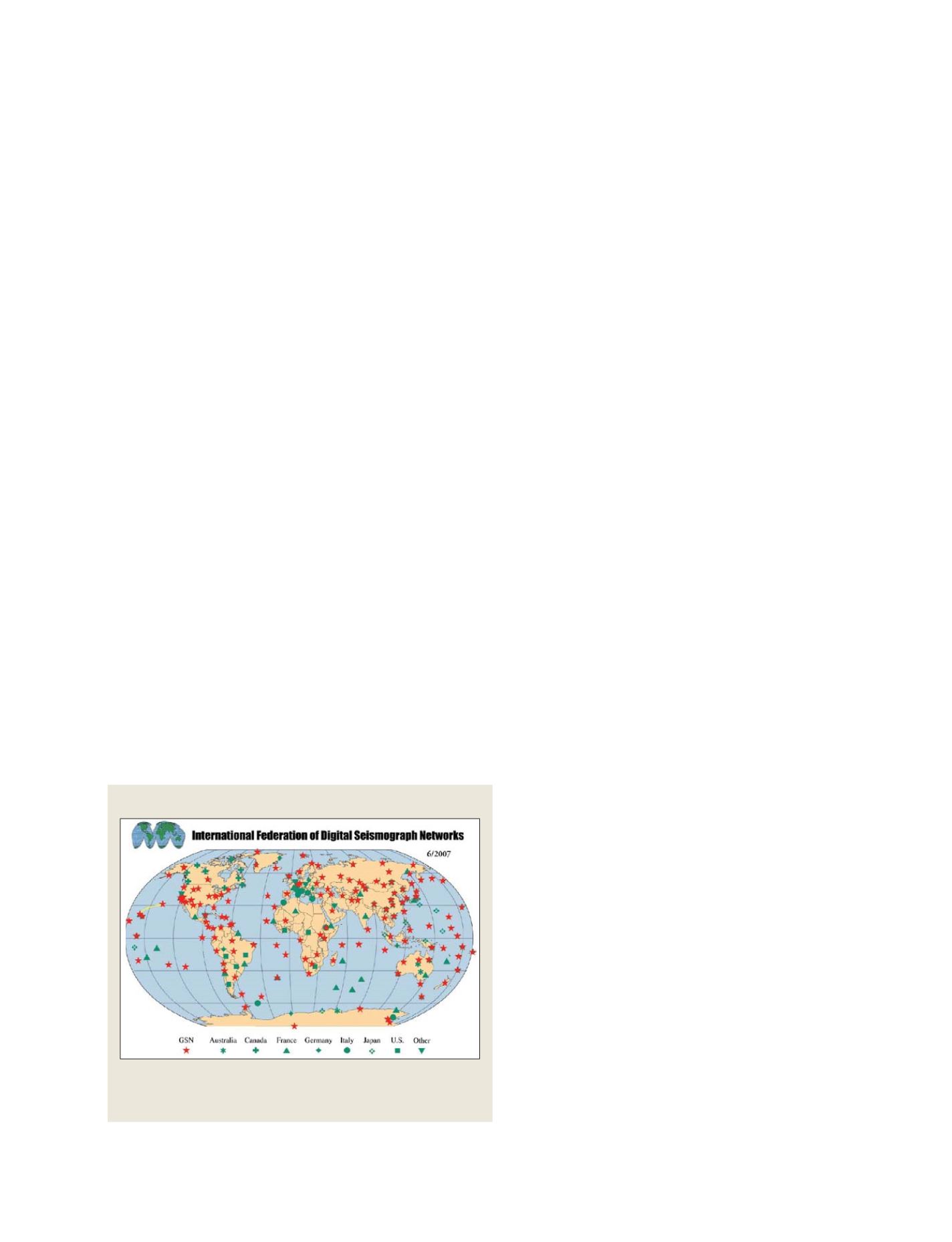

[
] 173
the number and quality of stations in those regions of the
world where station distribution is less than ideal. Some
examples of regions where seismographic coverage is
improving are Latin America, Africa and some parts of Asia.
The federation has given high priority to encouraging and
supporting the installation of stations on the bottom of the
oceans. The Earth, being essentially an oceanic planet, has
large areas where the installation of seismological observ-
ing stations is restricted to islands. Several international
efforts are underway, using cutting edge technology to
install seismographic stations in the various ocean basins.
FDSN and GEOSS: a fruitful interaction
In February 2005, the FDSN subscribed the ten-year imple-
mentation plan of GEO. In this manner, FDSN embraced
the goals of GEO by contributing seismological data of the
highest quality available, which may be distributed openly
for the benefit of society. As mentioned above, the federa-
tion has encouraged for many years the transmission and
distribution of data in real time, another of the main goals
of GEOSS. In fact, FDSN is probably the most developed
and integrated system of in situ observatories now
contributing to the GEOSS effort.
Within GEOSS, the FDSN offers the participation and
representation of a global community of seismographic
network operators in a coordinated and structuredmanner.
Additionally, the federation has contributed routinely to
GEO its expertise in the real-time transmission of data and
in the development of common formats and protocols for
the transmission, archiving, exchange and retrieval of data.
One of the main goals of GEOSS is the production and
distribution of information that allows the future develop-
ment of sustainable communities and societies. One of the
important elements for this is the prevention and reduc-
tion of the loss of lives and property caused by natural
disasters. FDSN provides GEOSS with the global infra-
structure that is crucial to meeting the societal benefit
enunciated by GEO of reducing disaster losses in the realm
of earthquakes and tsunamis.
The experience of the Sumatra and Indian Ocean
tsunami, which claimed over 300,000 lives in 2004,
eloquently illustrates the importance of strengthening and
improving the timely processing and distribution of rele-
vant data to support the efforts of international agencies
and governmental organizations in disaster relief and
prevention. Although the primary mission of the FDSN is
not disaster prevention, it is well aware of the importance
of the data that it produces for these efforts and strives to
maintain a close collaboration with those agencies respon-
sible for these tasks. Thus FDSN has offered its own
resources and its close collaboration and synergy with other
institutions like the US National Earthquake Information
Center, the EuropeanMediterranean Seismological Center
and the Intergovernmental Oceanographic Commission of
UNESCO (IOC), to actively contribute to two of the goals
of the ten-year implementation plan of GEO: the reduc-
tion of losses due to natural disasters and the understanding
of our environment as it may affect human lives and well-
being.
in Japan. In the exchange of data a common format called Standard for
the Exchange of Earthquake Data (SEED) was developed by one of the
working groups of the federation, and its use is strongly recommended.
This format, however, is not compulsory and members of the federa-
tion may transmit their data in a different manner. FDSN has also
developed software, which it also distributes freely, to convert into and
from SEEDmost of the formats used today. Common software developed
by the federation for data mining and retrieval from all data centres is
also freely and openly accessible to users and network operators.
The seismographic networks that contribute data to the federation
can be categorized into two main levels. There are global networks that
install and maintain a large number of seismographic observatories
distributed globally. The Global Seismographic Network (GSN) of IRIS,
GEOFON of Germany, GEOSCOPE of France and Pacific21 of Japan,
are examples of these global networks, and they all operate state-of-the-
art seismological observatories. These networks adhere strictly to the
recommendations of the FDSN of using broadband seismic instrumen-
tation to faithfully record the full spectrum of seismic signals with high
fidelity. The mission of these global networks is mainly scientific and
they all contribute and participate actively in the tsunami warning and
disaster prevention efforts at all levels.
Other seismographic networks that are also part of the FDSN are of
national, regional or local extent. These networks generally do not have
the production of data for scientific research as their main priority.
Instead, they are tasked to monitor seismicity and to contribute to the
evaluation of seismic hazard in their national territories or regions. These
operators are less demanding in the use of broadband seismic instru-
ments and data distribution, and exchange with other users or operators
is often controlled by their available technical and financial resources.
More and more of these operators, however, are now contributing data
to the FDSN data centres both in real time and in archival exchange.
The global exchange of seismic data is measured in tens of terabytes per
year.
The coverage of seismic observatories around the world is unfortu-
nately not homogeneous. The FDSN is collaborating with national and
international agencies and seismological network operators to improve
Geographic distribution of FDSN ‘Backbone’ stations
The FDSN ‘Backbone’ stations’ data are archived at the Data Management
Center of IRIS and distributed in real-time by FDSN members. The different
symbols indicate the different parent networks contributing the data
Annual mean
Source: Incorporated Research Institutions for Seismology (IRIS)
S
OCIETAL
B
ENEFIT
A
REAS
– D
ISASTERS
















